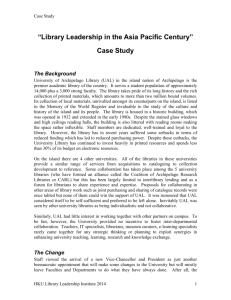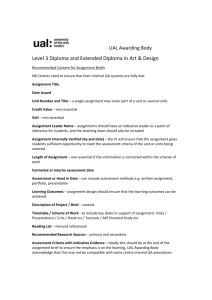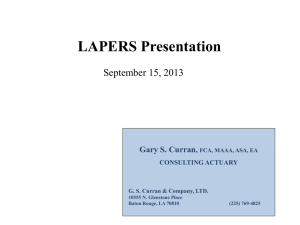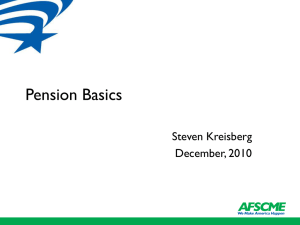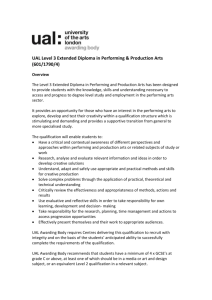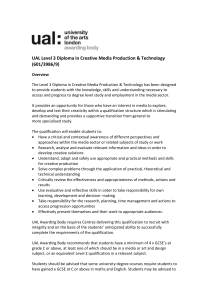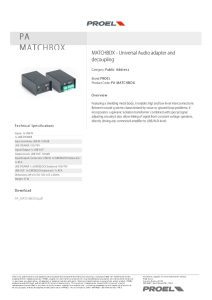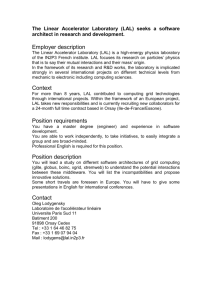Quality control Final exam: 2012/1/12 (Thur), 9:00
advertisement
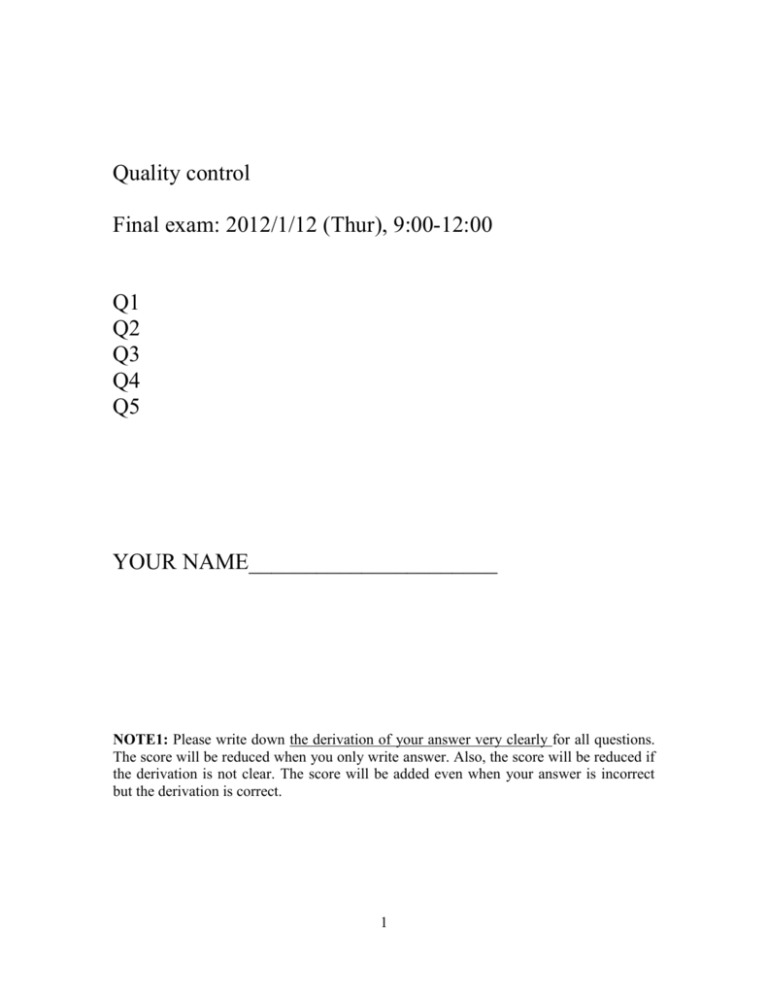
Quality control
Final exam: 2012/1/12 (Thur), 9:00-12:00
Q1
Q2
Q3
Q4
Q5
YOUR NAME______________________
NOTE1: Please write down the derivation of your answer very clearly for all questions.
The score will be reduced when you only write answer. Also, the score will be reduced if
the derivation is not clear. The score will be added even when your answer is incorrect
but the derivation is correct.
1
Q1 Basic calculations / Over-dispersion.
Chips of an engineering plastic have average size 45mm and standard deviation 3mm.
Upper and lower specification limits for the chips are 48mm and 41mm, respectively.
1) Suppose that X 1 ,..., X 9 are the size of the chips. Then, what is the probability of X
being outside the specification limit?
2) We obtained sizes of chips (39, 44, 39, 41, 47). Find an estimate of the standard
deviation by “range method” (use table).
3) Let {Y1 , Y2 , Y3 } be a independent sequence of 0-1 variables (Bernoulli trials) with
1 with probability 0.5
Pr(Yi 1)
, (i 1,2,3) , Compute
0 with probability 0.5
Var ( X ), where X Y1 Y2 Y3 .
4) Let {Y1 , Y2 , Y3 } be a sequence of 0-1 variables with
1 with probability 0.5
Pr(Yi 1)
, (i 1,2,3) ,
0 with probability 0.5
and let Pr(Y j 1 1 | Y j 1) 0.8, ( j 1,2) . Derive
Pr(Y j 1 0 | Y j 1)
Pr(Y j 1 1 | Y j 0)
Pr(Y j 1 0 | Y j 0)
5) Compute Var ( X * ), where X * Y1 Y2 Y3 .
6) Show over-dispersion in the above example.
2
Q2. Shewhart chart for continuous variable
We conduct the testing hypothesis:
H 0 : B 0 versus H1 : B 0
for the following data of k=5 groups and n=4 samples.
Group
i=1
i=2
i=3
i=4
i=5
Mean
10
22
13
12
14
16
20
15
13
14
12
22
12
15
9
10
16
12
12
11
1)
Conduct a test for H 0 : B 0 (5% level).
2)
Draw a X -Chart (draw both action limits and warning limits)
3)
Draw a Range-chart (draw both action limits and warning limits)
3
si2
Range
Q3. Average run length for X -chart
~
Let R be the run length for X -Chart with both warning and action limits.
~
~
1) E R | X1 [LWL, UWL] =
, (in terms of E[R ] )
~
ER | X
~
ER | X
~
ER | X
~
ER | X
~
ER | X
1
[LAL, UAL] =
1
~
[UWL, UAL], X 2 [LWL, UWL] =_____, (in terms of E[R ] ).
1
[UWL, UAL], X 2 [LAL, UAL] =_____.
1
[UWL, UAL], X 2 [UWL, UAL] =_____.
.
[UWL, UAL], X [LAL, LWL]=
~
( in terms of ER | X [LAL, LWL] )
1
2
,
1
2) Let p0 Pr(LWL X1 UWL) , p1 Pr(UWL X 1 UAL ) ,
~
p2 Pr(LAL X 1 LWL) . Derive E[R ] in terms of p0 , p1 and p2 .
~
3) Derive E R | X 1 [UWL, UAL] .
4) Let X ij ~ N ( , 2 ) with 2 / n , and UAL= 3 / n , UWL= 2 / n ,
~
~
LWL= 2 / n , LAL= 3 / n . Calculate p0 , p1 , p2 and E[R ] . Compare E[R ]
with the value in Table below.
4
Q4. Control chart from specification limit
1. Draw X -Chart and derive sample size for the following set of parameters under
action limit only and a single specification limit at USL=0.
NOTE: Denote the position of USL, UAL, and center. No need to write theoretical
derivation.
Producer’s risk point Consumer’s risk point
pa
0.01
La
300
pr
0.05
Lr
5
X ij ~ N ( , 2 )
1
2
2. In practice, USL is not 0. For instance, the upper specification limit for the size of
chips is 48mm. Why one can always set USL=0 without loss of generality?
(this problem has some erroneous point about the position of “center”)
5
Q5. Control chart for discrete data
A manufacture conducts a waterproof testing for 5 electric boards in a PC. The number of
electric circuits and the number of defective circuits on the board is recorded as follows:
Board ID
The number of defectives circuits
The number of circuits
1
10
200
2
20
200
3
20
200
4
35
200
5
15
200
1. This data type is called (attribute data / countable data / continuous data) since the
number of defective circuits follows (Binomial distribution / Poisson distribution /
Normal distribution). A suitable chart is (c-Chart / np-Chart / X -Chart).
2. The dispersion test is to test the hypothesis: H 0 :
. (write a formula)
3. Compute test statistic ( D ) and the cut-off point, and then test H 0 .
4. Draw a control chart (both action and warning limits). Is the data in-control or out-ofcontrol?
6
Tables
x2
1
exp dx
2
2
z
p
Table: the normal distribution
z
P
0.5
0.6915
0.84
0.80
1
0.8413
1.5
0.9332
1.64
0.95
2
0.9772
2.33
0.99
2.5
0.9938
2.71
0.9967
3
0.9986
Table: Conversion of range to standard deviation
n
2
1.128
dn
3
1.683
4
2.059
5
2.326
6
2.534
Table: Square, square-root table
number square square root
5
25
2.236
6
36
2.449
7
49
2.646
8
64
2.828
9
81
3.000
10
100
3.162
11
121
3.317
12
144
3.464
Table: Factors for constructing range charts from an average range
Action limit
Warning limit
n
4
5
D1
D3
D3
D4
0.16
0.21
2.36
2.22
0.37
0.42
1.81
1.72
Table: Average run length for various sizes
Deviation:
/( / n )
from the target value
Average ran length (ARL)
0
278
0.5
100.06
1
25.61
1.5
8.78
2
4.07
2.5
2.41
Table: Critical point of F-distribution: F0.05(df1, df2)
df1=1
2
3
4
5
6
7
8
9
df2=10
4.96
4.10
3.71
3.48
3.33
3.22
3.14
3.07
3.02
11
4.84
3.98
3.59
3.36
3.20
3.09
3.01
2.95
2.90
12
4.75
3.89
3.49
3.26
3.11
3.00
2.91
2.85
2.80
13
4.67
3.81
3.41
3.18
3.03
2.92
2.83
2.77
2.71
14
4.60
3.74
3.34
3.11
2.96
2.85
2.76
2.70
2.65
15
4.54
3.68
3.29
3.06
2.90
2.79
2.71
2.64
2.59
16
4.49
3.63
3.24
3.01
2.85
2.74
2.66
2.59
2.54
17
4.45
3.59
3.20
2.96
2.81
2.70
2.61
2.55
2.49
7
3.5
0.99977
4
0.99997
Degrees of freedom (df)
χ2 value
1
0.004 0.02 0.06 0.15 0.46 1.07 1.64 2.71 3.84 6.64 10.83
2
0.10 0.21 0.45 0.71 1.39 2.41 3.22 4.60 5.99 9.21 13.82
3
0.35 0.58 1.01 1.42 2.37 3.66 4.64 6.25 7.82 11.34 16.27
4
0.71 1.06 1.65 2.20 3.36 4.88 5.99 7.78 9.49 13.28 18.47
5
1.14 1.61 2.34 3.00 4.35 6.06 7.29 9.24 11.07 15.09 20.52
6
1.63 2.20 3.07 3.83 5.35 7.23 8.56 10.64 12.59 16.81 22.46
7
2.17 2.83 3.82 4.67 6.35 8.38 9.80 12.02 14.07 18.48 24.32
8
2.73 3.49 4.59 5.53 7.34 9.52 11.03 13.36 15.51 20.09 26.12
9
3.32 4.17 5.38 6.39 8.34 10.66 12.24 14.68 16.92 21.67 27.88
10
3.94 4.86 6.18 7.27 9.34 11.78 13.44 15.99 18.31 23.21 29.59
P value (Probability) 0.95 0.90 0.80 0.70 0.50 0.30 0.20 0.10 0.05 0.01 0.001
8
IMPORTANT NOTE:
This is a very simplified answer. In the exam, you need to write down more detailed
calculations.
Answer1.
1) X ~ N (45,1) , Pr( X 41) Pr( X 48) Pr(Z 4) Pr(Z 3) 0.0014
2) sd=(47-39)/2.326 = 3.44
3) Var(X ) =3*(1/2)*(1/2)=3/4=0.75
4) Pr(Y j 1 0 | Y j 1) =1-0.8=0.2,
Pr(Y j 1 1 | Y j 0) Pr(Y j 0, Y j 1 1) / Pr(Y j 0)
{Pr(Y j 1 1) Pr(Y j 1, Y j 1 1)} / Pr(Y j 0) (1 / 2 0.8 / 2) /(1 / 2) 0.2
Pr(Y j 1 0 | Y j 0) =1-0.2=0.8
5) Pr( X * 0) Pr(Y1 0, Y2 0, Y3 0) (1 / 2) * 0.8 * 0.8 0.32 .
Pr( X * 1) 0.18, Pr( X * 2) 0.18, Pr( X * 3) 0.32 .
Var ( X * ) 0.32 * (1.5) 2 0.18 * (0.5) 2 0.18 * (0.5) 2 0.32 * (1.5) 2 1.53
6)Over-dispersion since Var ( X * ) 1.53 0.75 Var ( X ) .
Answer2
1) Overall mean=14, s B2 =46/4=11.5, sW2 =26/5=5.2, F nsB2 / sW2 =46*5/26=8.85
Critical point=F(k-1,(n-1)*k)=F(4, 15)=3.06 (5%). Reject H 0 : B 0 .
2) LAL=14-3*3.4=3.8, UAL=14+3*3.4=24.2,
LWL=14-2*3.4=7.2, UWL=14+2*3.4=20.8.
(Add these line and group means in the chart).
3) R =23/5=4.6
LAL=0.16*4.6=0.736, UAL=2.36*4.6=10.856,
LWL=0.37*4.6=1.702, UWL=1.81*4.6=8.326.
(Add these line and ranges in the chart)
Answer3
~
~
1) E R | X1 [LWL, UWL] = 1+ E[R ]
~
ER | X
~
ER | X
~
ER | X
~
ER | X
~
E R | X1 [LAL, UAL] = 1 .
1
~
[UWL, UAL], X 2 [LWL, UWL] =2+ E[R ]
1
[UWL, UAL], X 2 [LAL, UAL] =2.
1
[UWL, UAL], X 2 [UWL, UAL] =2.
1
[UWL, UAL], X 2
~
[LAL, LWL]= 1+ ER | X
9
1
[LAL, LWL]
~
2) E[ R ]
(1 p1 )(1 p2 )
(see your notes for derivation)
1 p0 p0 p1 p0 p2 p1 p2 p0 p1 p2
~
E[ R ] 1 p1
~
E R | X 1 [ UWL, UAL]
1 p1
(1 p1 )(1 p2 )
1 p1
1 p0 p0 p1 p0 p2 p1 p2 p0 p1 p2
1 p1
3)
(1 p2 )
1
1 p0 p0 p1 p0 p2 p1 p2 p0 p1 p2
4) Since X1 ~ N (2 / n , 2 / n) , Z ( X1 2 / n ) /( / n ) ~ N (0,1) .
p0 Pr(2 / n X 1 2 / n ) Pr(4 Z 0) 0.5 ,
p1 Pr(0 Z 1) 0.8413 0.5 0.3413, p2 Pr(5 Z 4) 0 .
~
E[R ] =(1+0.3413)/(1-0.5-0.5*0.3413)=1.3413/0.33=4.06. This is close to 4.07 in the
Table.
Answer4
1.
pa =0.01 Z pa =2.33, pr =0.05 Z pr =1.64
La =300 qa 1 / La =0.0033 Z qa =2.71, Lr =5 qr 1 / Lr =0.2 Z qr =0.84.
n ( Z qa Z qr ) 2 /(Z pa Z pr ) 2 =(2.71-0.84)^2/(2.33-1.64)^2=(1.87/0.69)^2=7.34.
Set n =8.
k A Z pa Z qa / n =2.33-2.71/sqrt(8)=1.37.
UAL=- k A =-1.37*2=-2.74, center=- =-2 (usually, center is below UAL).
2. If USL=48mm for a variable X, set a new variable Y=X-48. Then, USL for Y is 0.
Answer 5
1) Attribute data; Binomial distribution; np-Chart.
2) H 0 : Var ( X i ) np(1 p) , where X i is the number of defectives with ID = i , and p is
unknown probability of being defective in the circuit.
3) p̂ =0.1, X =20, s 2 =350/4=87.5, s 5 7 2 / 2 =5*2.646*1.414/2= 9.354.
D=350/(200*0.1*0.9)=19.44 > df2 4 (0.95) =9.49. Reject H 0 : Var ( X i ) np(1 p) .
4)UAL=20+3*9.354=48.062, UWL=20+2*9.354=38.708,
LWL=20-2*9.354=1.292, LAL=20-3*9.354=-8.062 (set 0). In-control (Figure omitted).
10
